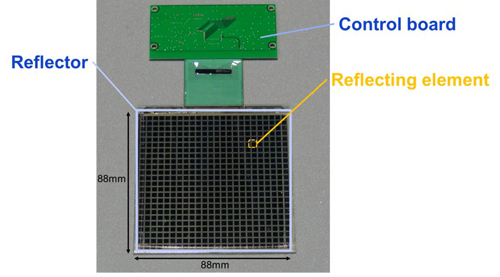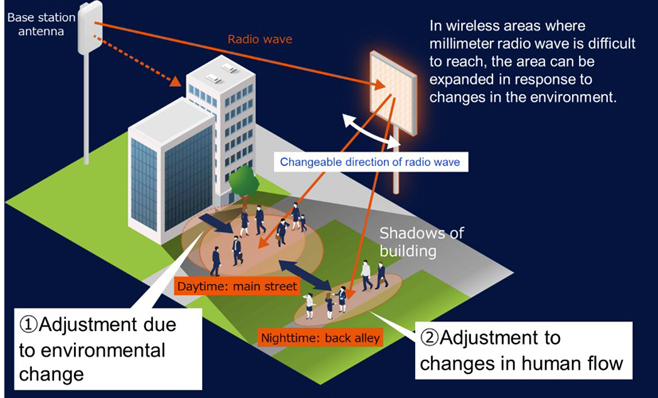 Print
Print
- Advanced Technology Laboratories
Development of the World’s First Direction-Variable Liquid Crystal Meta-Surface Reflector
– Improves 5G Mobile Communication –
October 7, 2021
KDDI Research, Inc.
Japan Display Inc.
KDDI Research, Inc. and Japan Display Inc. (JDI) today announced the development of the world’s first direction-variable liquid crystal meta-surface reflector for 5G mobile communication by applying JDI’s core liquid crystal display technology knowhow*1.
The meta-surface reflector can reflect radio waves at frequencies of 28GHz band in any programmed direction.
This technology enables a flexible expansion of 5G’s ultra-high-speed/high-capacity service area in response to the surrounding network environment.
This will greatly improve the user’s connection, convenience & experience.
While high frequency radio waves such as the 28GHz band used in 5G enable ultra-high-speed/high-capacity mobile communication services, these waves by nature travel in a direct line. This characteristic of the high frequency radio waves can then easily & frequently create “coverage holes”, such as areas behind buildings, trees, and other obstacles where the radio waves are hindered or blocked.
As a method of providing 5G services to such coverage hole locations, radio wave reflectors which reflect radio waves from base stations in specific directions and deliver them to the coverage holes, have great potential of providing an optimum solution.
KDDI Research, Inc. and JDI have developed a direction-variable liquid crystal meta-surface reflector which allows the direction of reflection to be programmed & changed electrically.
This direction-variable meta-surface reflector uses liquid crystals, which are used in certain displays, to control the direction of the radio waves reflection.
By applying voltages to any position of the reflecting elements, the dielectric constants of the liquid crystals which are placed in between the reflecting elements and the reference surface can be controlled. Consequently, the direction of the reflection of radio waves is defined electrically.
This achievement is expected to provide a promising solution for the coverage hole, since this will enable dynamic consideration of both the distribution of the users and the position of the coverage holes due to changes in the network & environment conditions.
KDDI Research, Inc. and JDI will proceed with empirical experiments in the 5G area with the aim of commercializing this technology.

Fig.1 Small sample of direction-variable liquid crystal meta-surface reflector.

Fig.2 Practical image of direction-variable liquid crystal meta-surface reflector.
*1 KDDI Research, Inc. survey, October 7, 2021
※The information contained in the articles is current at the time of publication.Products, service fees, service content and specifications, contact information, and other details are subject to change without notice.